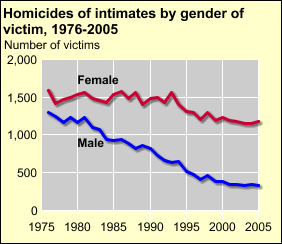The Duluth Model
Historically domestic violence was considered a 'personal problem.' However as the twentieth century progressed, some efforts were made within the public health, psychotherapeutic, and social service communities to address the problem. Almost inevitably, these efforts were organized around the idea of fixing the relationship. Violence was largely unaffected. During the years of the Vietnam War, more American women were killed by intimate partners than were Americans killed in combat.
In the early eighties, some workers in the field of domestic violence, coalescing in the city of Duluth, called for a different model of intervention. In this model, the goal was to stop the violence. Fixing the relationship was not the goal. Because of that, the model was free to be a model of social intervention, not a model of personal change. Below are a couple of graphs, from the bureau of justice statistics, showing trends in domestic (and other) violence. (In these graphs, unlike the rest of this website, the legal, rather than the behavioral definition of abuse is being used.)


In the graph on the left, the reduction in intimate partner violence in the 16-49 age groups since the 'Duluth Model' has gained currency is startling. On the right, the decrease in the homicide of males is very conspicuous. Could it be that the Duluth Model helps men more than women because it provides relief to the survivor short of killing the primary aggressor?
The above discussion briefly puts into context the goal of the Duluth model. Below are some assumptions of the model that have proven controversial:
- Not all violence is equal. Some violence is part of relentless pressure to control others, some violence is an effort not to be controlled or to survive. To be blind to this distinction leads to actually lending a hand to the powerful who can evade accountability better than their survivors. Because males are more inclined to use power systematically and also more inclined to try solve problems by controlling their partners, this distinction identifies males overwhelmingly. Hence the misunderstanding that the Duluth model is at its core just a bias against men.
- The primary burden for ending the abuse belongs to the community and the primary aggressor, not the survivor. That is, abuse is not a personal problem. This recognizes that survivors, by definition, need some equalization. It also means that once the system gets involved, the survivor loses most of her say so about what happens. If the agencies involved responded in accord with the survivor's wishes at any moment, it would make manipulating the survivor an even greater prize for the primary aggressor. (this is in fact the 'old way', with the greater mortality)
- All agencies must work for the survivor's safety. This is necessary to prevent agencies from being turned against each other and against the survivor, the dynamics of primary aggression being as insidious as they are. For those working with primary aggressors in 'treatment' programs, the normal allegiance a therapist has for a client is not operative, and it should not be pretended. In its place can be offered respect, courtesy, honesty, and time and experience.
- Primary aggressors must be held accountable. That is, they must be honest about what happened. (In those rare occasions where honesty actually happens, making amends and reparations tends to proceed spontaneously.) This honesty is a fundamental of all offender treatment. Only when there is no dispute about what happened can any fruitful efforts to decrease its happening occur. This is perhaps the most difficult step in the whole effort to decrease domestic violence. In the author's experience, it almost never happens.
It seems that it takes considerable emotional and attitude change on the part of primary aggressors before even a first step of agreeing that the abuse happened can occur. In this work of individual change the Duluth model is perhaps rightly seen to be lacking. As a curriculum for offenders, the Duluth model is just a statement of ethical precepts, which however laudable, in the context of court-ordered treatment, is received as finger wagging.
When the Duluth model was examined as a method of individual change, it was found unimpressive. However, it is, as stated above, more a sociological intervention than a model of individual change. It is perhaps a false assumption that safety must come through personality change of primary aggressors--that assumption really just goes back to the "fix the relationship" idea.
It is also good to remember that in the 1970's, societally-enforced individual accountability was much lower than today. Therapy and many other things were misused at times to avoid responsibility. The Duluth model does not forbid traditional therapy (a common misunderstanding) but rather forbids its use as evidence of accountability. Concurrent with and subsequent to 'batterer's treatment", other methods of change are still available to everyone, including 12-step, psycho-therapeutic, religious, educational, etc. (Couples therapy, with good reason, cannot be concurrent) 'Duluth' interventions merely provide a sanity-saving and sometimes life-saving basic structure on the community's response.
Despite being at its core a pragmatic model, the Duluth model is perceived as a political or philosophical position. Perhaps this is why: the impetus for the change in the way domestic violence was handled came from feminists. Explanations for the need for this model were both pragmatic and feminist. But pragmatic models demand changes based on trial and err, both in development, and in refinement. Thirty years after its initial formulation, the Duluth model has not changed much. There has been a split: pragmatic voices calling for some changes based on the experience of three decades, and some feminist voices calling for no change to protect gains in awareness of male privilege. For change to be valuable, and not merely a reverting to the previous state of affairs, it is necessary that all involved understand the reasons behind the 'rules'.